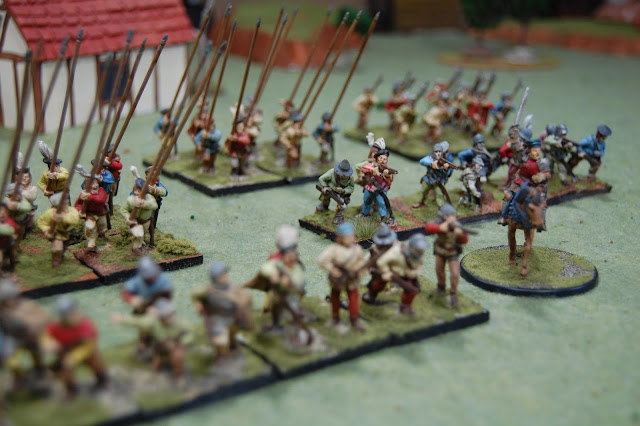Over the last winter I painted British and
Russian forces for the Crimean War using 1/72 plastics by Strelets. Strelets is notable for (a) using a
"chunky" 28mm-ish style of sculpts (which are fun to paint) and (b)
offering many sets consisting of, say, "40 figures in 40 poses",
which is ambitious and different, but does make "ranking up" war game
units visually a tad more difficult than usual.
They do also offer some sets that are the more typical 10 poses with 4
figures in each pose. I am planning to
run a 5-player (2 British vs. 3 Russian) game using The Men Who Would Be Kings, but having not played that rule set
since last December I wanted a refresher so a playtest resulted.
The scenario was adopted from the "Take
the High Road" one provided in the rulebook. That scenario calls for a 18-point
defending force vs. a 24-point attacker.
Since this a 2-3 ratio we set up two 23-point British commands vs. 3
Russian commands of between 21- and 23-points.
We also elected to use the optional rule of one leadership value for
each command as opposed to one for each unit. The British rolled exceptionally
well and ended up with two commanders with 5+ ratings (each unit would thus
need to roll a 5 or better on 2d6 to move, fire, etc.). We also chose to roll for "leader
traits", which game the British nothing exception. The Russians were in
trouble from the get go, however, as the commander of the Russian left
(consisting of half the Russian infantry), rolled two ones on his trait and
ended up being downgraded to a 10+ leadership (aka Major Hapless)!
Predictably, the Russian left immediately proceeded to fail 95% of its activation rolls and remained nearly stationary the entire game. The Russian center advanced at a fair pace and the massed Cossacks on the right flew forward led by some Russian dragoons.
The Scots Greys on the British left countered by sallying forth and were beaten back with heavy losses. However now at close range, the British were able to maximize their infantry firepower and the Cossack assault melted away.
Since the Russian left was still in the starting blocks, the British right was able to concentrate all its attention on the advancing Russian center, and the newer, longer range British rifled muskets whittled away the advancing Russian infantry until only small remnants remained.
The game's objective was for the Russians to occupy both earthworks by the end of 12 turns. It was now the end of turn 5 and the Russian left was gone and the center in tatters, while the right remained firmly in command of Major Hapless with his 10+ command rating, so the game was called early.


Below: starting positions.
Below: Russian dragoons are out in front in the middle of the board.
Below: Russian center advances.
Below: Cossacks assault the British left.



Below: State of the attack by end of turn four - Cossack assault almost entirely wiped out, Russian infantry assault in center reduced to a few stragglers, Pin markers everywhere...
The Men Who Would Be Kings is of course
supposed to be a colonial small battle rule set, and it does that very well, but
the book does say it's for conflicts as early as the 1840s so the Crimean
seemed like a decent fit. Both sides use standard Regular Infantry profiles,
but with points reduced for earlier firearms and reducing Discipline from a +1
to a 0 (the Crimea seeming to mainly feature inexperienced, novice, or
uncertain troops and commanders), so British infantry cost 4 points/unit and
Russian 3. Regular Cavalry only had a
one point deduction for shorter ranged firearms (5 points). Cossacks are unmodified Irregular Infantry (4
points). The result felt appropriate
based on the reading I have done on the Crimea, with nice-looking initial
deployments become haphazard and lots of individual unit initiative, and the
balance of the game hanging on utilization of superior numbers by the Russians
versus optimization of better firearms by the British.



























